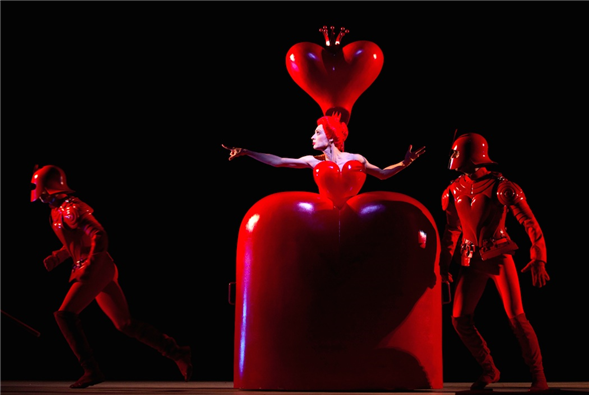By SUSAN REITER
It's not often that a completely original three-act ballet is unveiled, but next week the National Ballet of Canada will perform something fresh, new, and quite ambitious. Christopher Wheeldon's
Alice's Adventures in Wonderland translates the beloved Lewis Carroll tale into ingenious dance terms.
Given Carroll's extensive (and often whimsical) cast of characters, Wheeldon's ballet features numerous roles that he shaped with distinctive stylistic touches, blending the classical ballet vocabulary with elements of Broadway, music hall, pantomime, and acrobatics. The 41-year-old choreographer---whose next project is directing and choreographing the Broadway-bound
An American in Paris---told the
New York Times that he had more fun creating this work than any other in his already extensive career, and that seems true for the performers as well.
Robert Stephens, a first soloist who's been with NBC for ten years, has been performing as the Mad Hatter since the ballet's 2011 premiere in Toronto. (In New York, it will play September 9-14 at the David H. Koch Theater at Lincoln Center.) He added the White Rabbit more recently and will alternate the roles next week. "A lot of times, when you're putting on a really big production, sometimes the fun gets lost," he says. "With this ballet, the fun has definitely been there right from the beginning, and I think there's a lot of fun inherently in the source material."
Thanks to a vigorous tap routine, Stephens delivers Broadway razzle-dazzle, as well as a very specific flavor. "Christopher gave me some really great ideas and insight into the role," he says. "He mentioned both Johnny Depp and Keith Richards in his descriptions of what I should be aspiring to show. I think he was inspired by the Tim Burton film, and he gave me a great sense that behind this Mad Hatter there is the whimsy, but there's also a darkness.
"Of course I went back and looked at the original book. It's actually a hilarious scene. The Mad Hatter is very mean, but also very funny and witty. There's a lot of rhythm and wit in the words, and I think that translates really well into the tapping. I hadn't done any tap dancing since I was about eleven. I reached back to my training at a recreational school in the suburbs and put the tap shoes back on".
When he performs as the White Rabbit---who in the ballet's pre-Wonderland prologue is Lewis Carroll himself, a family friend of Alice Liddell---Stephens plays a more integral dramatic role. "It really is a different show for me when I dance the White Rabbit. Each entrance is very short, but my character really is one of the only ones who carries all the way through the ballet. I'm leading Alice on her journey. I feel very protective toward her---and proud of her by the end. It's a nice growth that I'm able to experience, in relation to her."
Greta Hodgkinson, a veteran principal dancer with the company, performs the juicy role of the Queen of Hearts. Initially seen in the prologue as Alice's none-too-maternal mother, she gets to cut loose with Wheeldon's spirited, often hilarious version of the Queen. "He conceived her as an amalgamation of a lot of ballerinas that he's worked with over the years, some of them diva-esque," she says. "She's a dual figure. I think he really wanted to see the difference between the mad, crazy Queen, but also this elegant ballerina. He wanted both of those sides to show."
Before she fully emerges, the Queen is wheeled on in a shiny red heart-shaped contraption, visible only from the neck up. (The set and costumes are designed by Tony award-winner Bob Crowley.) In those early appearances, Hodgkinson says, "You rely a lot on acting. Even though she's not dancing through those scenes where she's getting rolled on, it can be very expressive, and I think that it needs to be---not over-exaggerated---but it certainly needs to be larger than life. While you want to be real as the mother, as the Queen I think there's so much freedom to be a little bit crazy. Christopher wanted it to be funny. He himself could be very funny, and he enjoyed demonstrating the characters. I think he secretly would have loved to have danced the Queen!"
The role includes a devastating parody of the famous Rose Adagio from
The Sleeping Beauty, and Hodgkinson has performed the real thing often enough to appreciate and enjoy the send-up. "It's very specific in terms of choreography and counts. I think that within the structure of the piece, he wants each dancer to interpret it in her own way. What's funny about it is that if you take it seriously, then it's actually funny, because the choreography in and of itself is funny."
A three-act ballet relies on its music as much as its choreography, and both dancers praise Joby Talbot's melodic score, which assigns recurring motifs to major characters. "It' so tuneful but it also has so much depth and huge orchestrations that help elevate it," says Stephens. Hodgkinson adds, "It's not a hugely complicated story, but it's busy, with many characters. Each character has its own melody and theme, and that makes it a lot easier to find your character and relate to other people."
---
Susan Reiter is a freelance arts journalist who contributes to the Los Angeles Times, Playbill, Dance Magazine and other publications
Photo by Bruce Zinger
